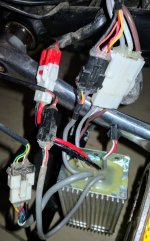theabsurdman
1 mW
- Joined
- Jul 15, 2022
- Messages
- 16
I recently acquired a pair of 10+ year old Giant pedelecs - a Twist Express and a Twist RS2 which are almost identical models except...
The Express can be easily derestricted by relocating its cadence sensor mounted on the rear triangle detecting a magnet affixed to a rear wheel spoke but I can't locate the equivalent on the RS2 wich has no obvious sensor and no spoke magnet!
Presumably the RS2 speed sensing is happening in the motor and there is indeed a white wire coming from the motor which has been designated "speed" in another ES thread. I tried cutting that but it just resulted in an error condition and no power.
I'm wondering if I buy the Twist Express cadence sensor part and try to wire that into the RS2 controller in place of the speed wire coming from the motor might that work to externalise the cadence-sensing.
Any other ideas?
The Express can be easily derestricted by relocating its cadence sensor mounted on the rear triangle detecting a magnet affixed to a rear wheel spoke but I can't locate the equivalent on the RS2 wich has no obvious sensor and no spoke magnet!
Presumably the RS2 speed sensing is happening in the motor and there is indeed a white wire coming from the motor which has been designated "speed" in another ES thread. I tried cutting that but it just resulted in an error condition and no power.
I'm wondering if I buy the Twist Express cadence sensor part and try to wire that into the RS2 controller in place of the speed wire coming from the motor might that work to externalise the cadence-sensing.
Any other ideas?



